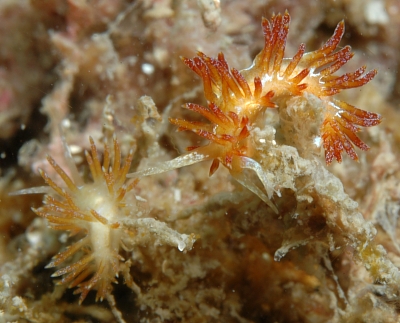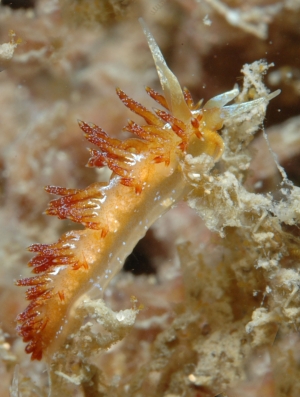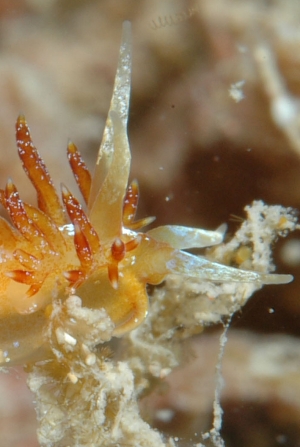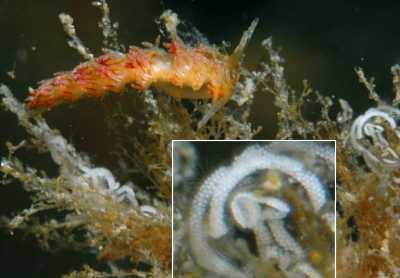Tularia bractea from eastern Australia
March 25, 2008
From: Leanne & David Atkinson

Dear Bill,
Over the last month we have repeatedly found this beautiful tiny Aeolid nudibranch in great numbers at both The Pipeline and Halifax. We haven't seen it before. It seems to be an Aeolid in shape. The ones we found at Halifax were on a number of different soft weedy things including the brown hydroid that Flabellina rubrolineata eats. We found them in greater numbers and with lots of eggs on Amathia tortuosa. Dave Harasti has also found it and is listing it on his web site as a new discovery and is calling it Fiery Phidiana, an appropriate name given the colours. We had started looking for it as a Flabellina. Neville Coleman has a similar photo listed as colour variation of Tularia bractea. What do you think? Can you suggest some identifying external features to differentiate a Flabellina from a Phidiana and a Tularia or is it all internal anatomy? Your help with this would be greatly appreciated.
Locality: The Pipeline and Halifax Sponge Gardens Port Stephens, 5metres to 17 metres, New South Wales, Australia, Pacific Ocean, 11 October and 14 October 2007, Sandy bottom with scattered sponges, hydroids, gorgonians, soft corals, ascidians, seaweeds and algae. Length: up to 15 mm. Photographer: Leanne & David Atkinson.
Best wishes,
Leanne & David Atkinson
atk@hunterlink.net.au



Dear Leanne & David,
This is an interesting find and I am pretty sure it is a colour form of Tularia bractea, although as usual - we would need to check its anatomy. That species has been previously reported from so far up the east coast of Australia but, previously been known from the Bass Strait region and New Zealand.
It is clearly not a species of Phidiana, or related genera, which have the cerata arranged in rows, but the rows are arranged in regular groups or clusters of up to 6 rows. The smooth rhinophores and long tentacular anterior foot corners are characters of Tularia, but probably the most characteristic feature are the ridges (or 'bracts') on which the cerata are inserted. very few aeolids have such pronounced structures.
Concerning them being on the bryozoan Amathia tortuosa. In your photo with the eggs, all I can see are hydroids. I have looked carefully at the full size files of your other two photos but can't see any sign of Amathia. All I can suggest is that the ones you saw on Amathia were there because the bryozoan had settled and grown on hydroid colonies which had been eaten out by the aeolid. Often when you see great numbers of egg ribbons on a hydroid colony you can be sure when you look closely that most of the hydroid polyps have been destroyed. I am afraid the life cycle of aeolids is quite short and brutal. They settle on a colony of hydroids and quickly eat all the polyps. If the colony is large enough the aeolid population will be able to mate and lay their eggs before the adult either die from old age or starvation.
Best wishes,
Bill Rudman
Related messages
-
Another Tularia bractea from New Zealand?
From: Ian Skipworth, September 11, 2007 -
Tularia bractea from New Zealand
From: Bill Rudman, September 11, 2007 -
Tularia bractea from New Zealand
From: Ian Skipworth, September 11, 2007 -
Cuthona scintillans from New Zealand
From: Ian Skipworth, November 8, 2005
